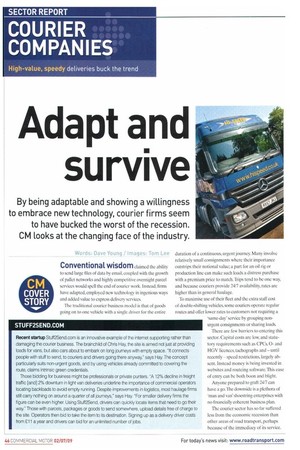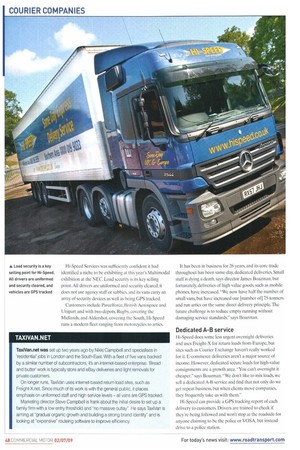Adapt and survive
Page 46

Page 48

Page 49

If you've noticed an error in this article please click here to report it so we can fix it.
By being adaptable and showing a willingness to embrace new technology, courier firms seem to have bucked the worst of the recession. CM looks at the changing face of the industry.
Worrin Dave Young / images: Tom Lee Conventional wisdom claimed the ability to send large files of data by email, coupled with the growth of pallet networks and highly competitive overnight parcel services would spell the end of courier work. Instead, firms have adapted, employed new technology in ingenious ways and added value to express delivery services.
The traditional courier business model is that of goods going on to one vehicle with a single driver for the entire duration of a continuous, urgent journey. Many involve relatively small consignments where their importance outstrips their notional value; a part for an oil rig or production line can make such loads a distress purchase with a premium price to match. Trips tend to be one way, and because couriers provide 24/7 availability, rates are higher than in general haulage.
lb maximise use of their fleet and the extra staff cost of double-shifting vehicles, some couriers operate regular routes and offer lower rates to customers not requiring a 'same-day' service by grouping nonurgent consignments or sharing loads There are few barriers to entering this
sector. Capital costs are low, and statutory requirements such as CPCs, 0and HGV licences, tachographs and — until recently — speed restrictions, largely absent. Instead money is being invested in websites and routeing software, This ease of entry can be both boon and blight.
Anyone prepared to graft 24/7 can have a go. The downside is a plethora of .man and van' shoestring enterprises with no financially coherent business plan.
The courier sector has so far suffered less from the economic recession than other areas of road transport, perhaps because of the immediacy of its service.
Hi-Speed Services was sufficiently confident it had identified a niche to be exhibiting at this year's Multimodal exhibition at the NEC. Load security is its key selling point. All drivers are uniformed and security cleared, it does not use agency staff or subbies, and its vans carry an array of security devices as well as being CEPS tracked.
Customers include Parcelforee, British Aerospace and Unipart and with two depots, Rugby, covering the Midlands, and Aldershot, covering the South, Hi-Speed runs a modern fleet ranging from motorcycles to artics. It has been in business for 26 years, and its core trade throughout has been same-day, dedicated deliveries. Small stuff is dying a death, says director James Boazman, hut fortunately, deliveries of high-value goods, such as mobile phones, have increased. "We now have half the number of small vans, but have increased our !number of] 7.5-tonners and run artics on the same direct delivery principle. The future challenge is to reduce empty running without damaging service standards," says Boazrnan.
Dedicated A-B service
Hi-Speed does some less urgent overnight deliveries and uses Freight-X for return loads from Europe, but sites such as Courier Exchange haven't really worked for it. E-comrnerce deliveries aren't a major source of income, However, dedicated secure loads for high-value consignments are a growth area. "You can't overnight it cheaper." says Boazman."We don't like to mix loads, we sell a dedicated A-B service and find that not only do we get repeat business, but when clients move companies, they frequently take us with them."
Hi-Speed can provide a GI'S tracking report of each delivery to customers. Drivers are trained to check if they're being followed and won't stop at the roadside for anyone claiming to be the police or VOSA, but instead drive to a police station. Boazman is looking into electronic POD, but says existing customers prefer a proper signature on hard copy, which is then scanned and sent by email.
Ile admits turnover is down for the first time in the company's history. but Hi-Speed has responded by expanding buying two established courier firms in the South. principally for their client base.
Like Hi-Speed, One2One Logistics relies on Mercedes Sprinters, putting 150,000 miles on its Sprinter vans in a year. "They routinely cover up to half a million miles before we stand them down." says MD Chris Phillips.
One2One's warehousing, logistics and distribution business specialises in urgent. awkward and just-in-time loads. Based in Risca, South Wales, its five Sprinters and three trucks operate an international door-to-door 'hot shot' delivery service for customers such as Airbus and ZF.
Its latest Sprinter chassis-cabs fitted with GPS tracking systems and specialised bodies, one a curtainsider, the other a box with sleeper pod have unlimited mileage. three-year warranties, and active and passive safety features, including adaptive ESP, which dynamically monitors the vehicle's load status. -We're very conscious of our duty of care obligations to employees and believe in ensuring our drivers are as safe as possible when travelling abroad," says Phillips.
Fuel returns
Neil "Iliomas, MD of Courier Direct in Bristol, says:-We've tried most vans, finally settling on Ford and Mercedes for the panel vans The Citroen Berlingo is a good small van.
"We keep the fleet fairly new Mercs are reliable and offer good residuals.
Thomas, his business partner and key staff came to the courier sector from a national overnight parcel network bringing large-firm methods of operation and organisation with them. Courier Direct is a 24/7 operation with a broad customer base of large and small firms, mainly founded on repeat orders with same-day work the key revenue source.
"It's not quiet,says Thomas of the current workload. "The first quarter was, but this is part of the usual business cycle for couriers. We're not expanding. but are actively seeking new business."
Courier Direct uses only employed drivers, including a number of older, semi-retired part-timers, on its 18-strong fleet. Whether a van is owned or leased depends on the type of work and the experience of the driver -Thomas reckons his older employees tend to cause less wear and tear and get better fuel returns.
Courier firms have embraced the internet more quickly and fully than other road transport areas, and you can't succeed in this sector without a sophisticated online presence, or using other computer-related and teleinatics technology. The biggest threats are from national networks with large infrastructures and cut-throat 'man and van' enterprises Is
















































































































































